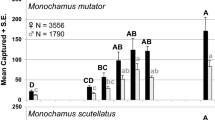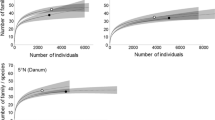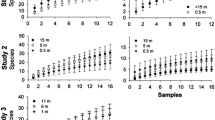Abstract
The response of insects to four thinning intensities (control, light-thin, heavy-thin, or light-thin with gaps) was examined in 40-to 60-year-old Douglas-fir stands on the Willamette National Forest in Oregon, USA. In both 2000 and 2001, flying insect assemblages were collected from window traps placed over the forest floor in the center of each treatment block during two annual intervals: 1 ) June through August (early-season) and 2) August through October (late-season). The seasonal responses by these insects showed statistically significant differences in species richness (F= 22.21,P <0.001) and mean abundance (F=34.87,P <0.001). The greatest numbers of taxa generated via indicator species analysis were in the early season and within the treatment of light-thin with gap (L./ G). In particular, the woodborer beetle,Buprestis (Burprestidae), was strongly associated with L/G (Indicator Value = 52.4, P ≤0.001 ). Two beetle taxa,Ampedus (Elateridae, IV=84.7, P ≤0.001 ) and members of Cermabycidae (IV=58.4, P ≤0.001 ), were correlated significantly with early-season, whereasMelanoplus (Acrididae) was associated with late-season (IV=21.3, P >0.05) and L/G (IV=29.2, P ≤0.05). For all thinning treatments, the numbers of species and individuals were higher in the early season than the late season. Non-metric multidimensional scaling showed that Axis 1 (65%) and Axis 2 (27%) explained 92% of the variance. The former was strongly associated with thinning intensity, having higher coefficients of species richness (r=0.645) and species diversity (r=0.583). The multi-response permutation procedures showed a statistically significant difference for thinning intensity (T-statistics=-4.6322,A-statistics=0.0479,P <0.0001 ). These results suggest that heavier thinning can result in more diverse populations of flying insects, including herbivores and predators.
Similar content being viewed by others
Literature Cited
Amman GD, McGregor MD, Schmitz RF, Oakers RD (1988) Susceptibility of lodgepole pine to infestation by mountain pine beetles following partial cutting of stands. Can J For Res18: 688–695
Batzer HO (1976) Silvicultural control techniques for the spruce budworm,In Proceedings of a Symposium on the Spruce Budworm. USDA Forest Service Miscellaneous Publication 1327, Alexandria, pp 110–116
Beals EW (1984) Bray-Curtis ordination: An effective strategy for analysis of multivariate ecological data. Adv Ecol Res14: 1–55
Biondini ME, Mielke PW, Berry KJ (1988) Data dependent permutation techniques for the analysis of ecological data. Vegetatio75: 161–168
Bohac SA, Lattig MD, Tucker GF (1997) Initial Vegetative Response to Alternative Thinning Treatments in Second Growth DouglasFir Stands of the Central Oregon Cascades. The Evergreen State College, Olympia, pp 47
Clarke KR (1993) Non-parametric multivariate analyses of changes in community structure. Aust J Ecol18: 117–143
Cody ML (1986) Diversity, rarity and conservation in Mediterranean-climate regions,In ME Soulé, ed, Conservation Biology, The Science of Scarcity and Diversity. Sinauer, Sunderland, pp 122–152
Cronin JT, Hayes JL, Turchin P (2000) Evaluation of traps used to monitor southern pine beetle aerial populations and sex ratios. Agricult For Entomol2: 69–76
Dufrêne M, Legendre P (1997) Species assemblages and indicator species: The need for a flexible asymmetrical approach. Ecol Monograph67: 345–366
Garman SL (2000) Response of ground-dwelling vertebrates to thinning young stands: The young stand thinning and diversity study. Annual Report to US Forest Service, Corvallis
Garman SL (2001) Response of ground-dwelling vertebrates to thinning young stands: The young stand thinning and diversity study. Annual Report to US Forest Service, Corvallis
Gunther PM, Horn BS, Babb GD (1983) Small mammal populations and food selection in relation to timber harvest practices in the western Cascade Mountains. Northwest Sci57: 32–44
Hagar J (2003) Linkage among birds, arthropods, and understory vegetation in western Oregon Douglas-fir forests. Ph.D. dissertation, Oregon State University, Oregon
Hagar J, Starkey E (2002) Birds,In PS Muir, RL Mattingly, JC Tappeiner II, JD Bailey, WE Elliott, JC Hagar, JC Miller, EB Peterson, EE Starkey, eds, Managing for Biodiversity in Young Douglas-Fir Forests of Western Oregon. Biological Sciences Report USGS/BRD/BSR-2002-0006. US Department of Interior, pp 37–40
Han HS, Kellogg LD (2000) Damage characteristics in young Douglas-fir stands from commercial thinning with four timber harvesting systems. West J Appl For15: 27–33
Harrington R, Fleming RA, Woiwod IP (2001) Climate change impacts on insect management and conservation in temperate regions: Can they be predicted? Agr For Ent3: 233–240
Hasegawa K, Futai K, Miwa S, Miwa J (2004) Early embryogenesis of the pinewood nematodeBursaphelenchus xylophilus. Dev Growth Differ46: 153–161
Hayes JR Weikel J, Huso M (2003) Response of birds to thinning young Douglas-fir forests, Cooperative Forest Ecosystem Research FS-033-03, USGS, US Department of Interior
Hodkinson ID, Hughes MK (1982) Insect Herbivory. Chapman and Hall, London, New York, pp 77
Hooven EF, Black HC (1976) Effects of some clearcutting practices on small mammal populations in western Oregon. Northwest Sci50: 189–208
Hunter MG (1993) Communique: Young Managed Stands. Cascade Center for Ecosystem Management, U.S. Forest Service, Blue River, pp 16
Hunter MD (2001) Insect population dynamics meets ecosystem ecology: Effects of herbivory on soil nutrient dynamics. Agricult For Entomol3: 77–84
Hunter MD (2002) Landscape structure, habitat fragmentation, and the ecology of insects. Agricult For Entomol4: 159–166
Kruess A, Tscharntke T (1994) Habitat fragmentation, species loss, and biological control. Science264: 1581–1584
Kruskal JB (1964) Nonmetric multidimensional scaling: A numerical method. Psychometrika29: 115–129
Lance DR (1983) Host-seeking behavior of gypsy moth: The influence of polyphagy and highly apparent plants,In S Ahmad, ed, Herbivorous Insects: Host-seeking Behavior and Mechanisms. Academic Press, New York, pp 201–224
Larson DJ (2001) The Effects of Thinning on Forest-Floor Small Mammals in the Coast Range of Oregon. M.S. Thesis, Oregon State University, Corvallis
Lehmkuhl JF, West SD, Chambers CK, McComb WC, Manuwal DA, Aubry KB, Erickson JL, Gitzen RA, Leu M (1999) Assessing wildlife response to varying levels and patterns of green-tree retention in western Oregon and Washington. Northwest Sci73: 45–63
Lorio PL Jr (1980) Loblolly pine stocking levels affect potential for southern pine beetle infestation. South J Appl For4: 162–165
Lowman MD, Rinker HB (2004) Forest Canopy, Ed 2. Elsevier Press, Oxford, pp 517
Mather PM (1976) Computational Methods of Multivariate Analysis in Physical Geography. John Wiley and Sons, London
McCune B (1994) Improving community analysis with the Beals smoothing function. Ecoscience1: 82–86
McCune B, Grace JB (2002) Analysis of Ecological Communities. MjM Software Design, Gleneden Beach
McCune B, Mefford MJ (1999) PC-ORD. Multivariate Analysis of Ecological Data, Version 4.0. MjM Software Design, Gleneden Beach
Mclntosh RL, Katinic PJ, Allison JD, Borden JH, Downey DL (2001) Comparative efficacy of five types of trap for woodborers in the Cerambycidae, Buprestidae and Siricidae. Agricult For Entomol3: 113–120
McMillin JD, Wagner MR (1993) Influence of stand characteristics and site quality on sawfly population dynamics,In MR Wagner, KF Raffa, eds, Sawfly Life History Adaptations to Woody Plants. Academic Press, New York, pp 333–361
Muzika RM, Liebhold AM (2000) A critique of silvicultural approaches to managing defoliating insects in North America. Agricult For Entomol2: 97–105
Pettersson RB, Ball JP, Renhorn KE, Esseen PA, Sjoberg K (1995) Invertebrate communities in boreal forest canopies as influenced by forestry and lichens with implications for passerine birds. Biol Conserv74: 57–63
Progar RA, Schowalter TD, Work T (1999) Arboreal invertebrate responses to varying levels and patterns of green-tree retention in northwestern forests. Northwest Sci73: 77–86
Raynolds BC, Hunter MD (2004) Nutrient cycling,In MD Lowman, HB Rinker, eds, Forest Canopies. Elsevier Press, Oxford, pp 387–396
Ribe R (1999) Regeneration harvests versus clearcuts: Public views of the acceptability and aesthetics of Northwest Forest Plan harvests. Northwest Sci73: 102–117
SAS Institute (2001) PROC User’s Manual. Version 6.0, SAS Institute, Cary
Schowalter TD (1994) Invertebrate community structure and herbivory in a tropical rainforest canopy in Puerto Rico following Hurricane Hugo. Biotropica26: 312–319
Schowalter TD (1995) Canopy arthropod communities in relation to forest age and alternative harvest practices in western Oregon. For Ecol Manag78: 115–125
Schowalter TD (2000) Insect Ecology: An Ecosystem Approach. Academic Press, San Diego
Schowalter TD, Crossley DA Jr (1988) Canopy arthropods and their response to forest disturbance,In WT Swank, DA Jr Crossley, eds, Forest Hydrology and Ecology at Coweeta. Springer-Verlag, New York, pp 207–218
Schowalter TD, Ganio LM (1998) Vertical and seasonal variation in canopy arthropod communities in an old-growth forest in southwestern Washington, USA. Bull Entomol Res88: 633–640
Schowalter TD, Hargrove WW, Crossley DA Jr (1986) Herbivory in forested ecosystems. Annu Rev Entomol31: 177–196
Schowalter TD, Zang YL, Rykken JJ (2003) Litter invertebrate responses to variable density thinning in Western Washington forest. Ecol Appl13: 1204–1211
Sokal RR, Rohlf FJ (1995) Biometry: The Principals and Practice of Statistics in Biological Research, Ed 3. W.H. Freeman, New York
Southwood TRE (1978) Ecological Methods, with Particular Reference to the Study of Insect Populations, Ed 2. Chapman and Hall, London
Stork NE, Didham RK, Adis J (1997) Canopy arthropod studies for the future,In NE Stork, J Adis, RK Didham, eds, Canopy Arthropods. Chapman and Hall, London, pp 551–561
Sullivan TP (1979) Demography of populations of deer mice in coastal forest and clear-cut (logged) habitats. Can J Zool57: 1636–1648
Sullivan TP, Sullivan DS, Lindgren PM (2001) Stand structure and small mammals in young lodgepole pine forest: 10-year results after thinning. Ecol Appl11: 1151–1173
Williams DW, Liebhold AM (2002) Climate change and the outbreak ranges of two North American bark beetles. Agricult For Ent4: 87–99
Yi HB (2003) Response of Arthropods to Different Intensities of Thinning in Oregon. Ph.D. dissertation, Oregon State University, Corvallis
Yi HB, Moldenke AR (2005) Response of ground-dwelling arthropods to different thinning intensities in young Douglas-fir forests of Western Oregon. Environ Ent34: 1071–1080
Zobel DB, McKey A, Hawk GH, Dyrness CT (1976) Relationships of environment to composition, structure, and diversity of forest communities of the Central Western Cascades of Oregon. Ecol Monograph46: 135–156
Author information
Authors and Affiliations
Corresponding author
Rights and permissions
About this article
Cite this article
Yi, H. Effect of thinning on flying insect communities using window traps in young douglas-fir (Pseudotsuga menziesii (Mirb.) Franco) forests in the Pacific Northwestern America. J. Plant Biol. 50, 190–197 (2007). https://doi.org/10.1007/BF03030629
Received:
Accepted:
Issue Date:
DOI: https://doi.org/10.1007/BF03030629




